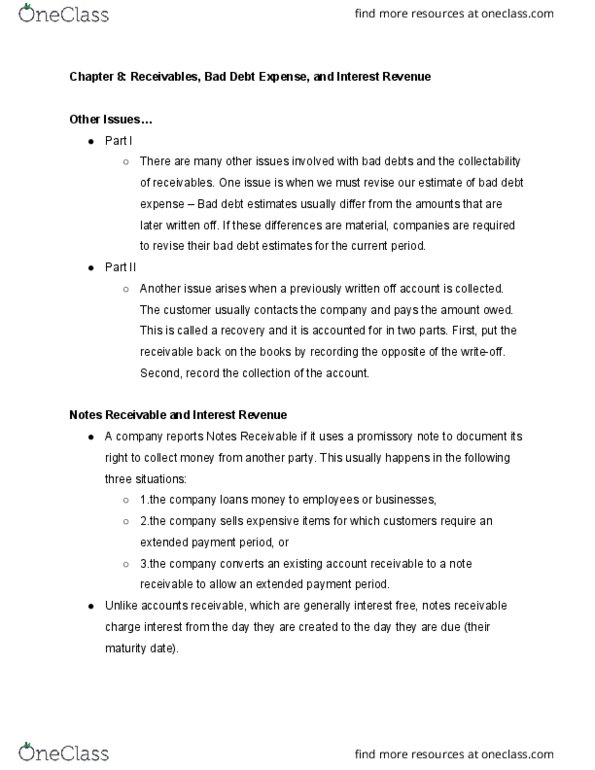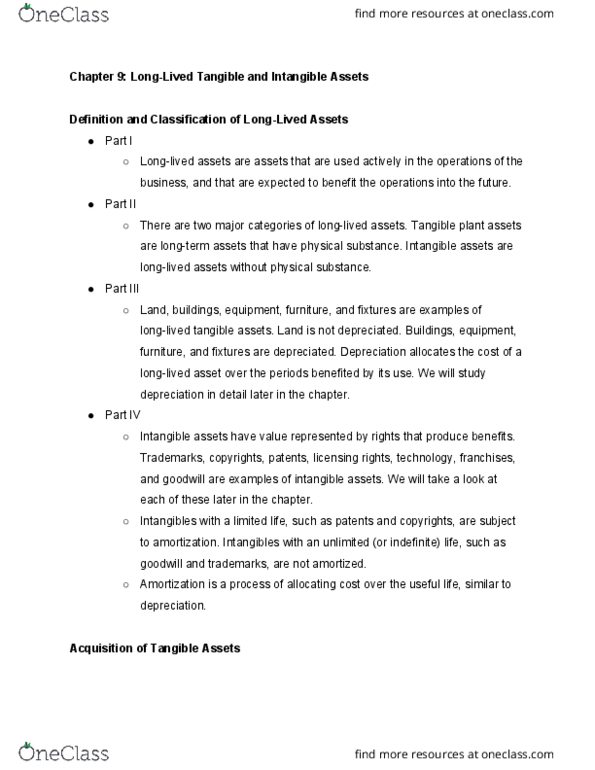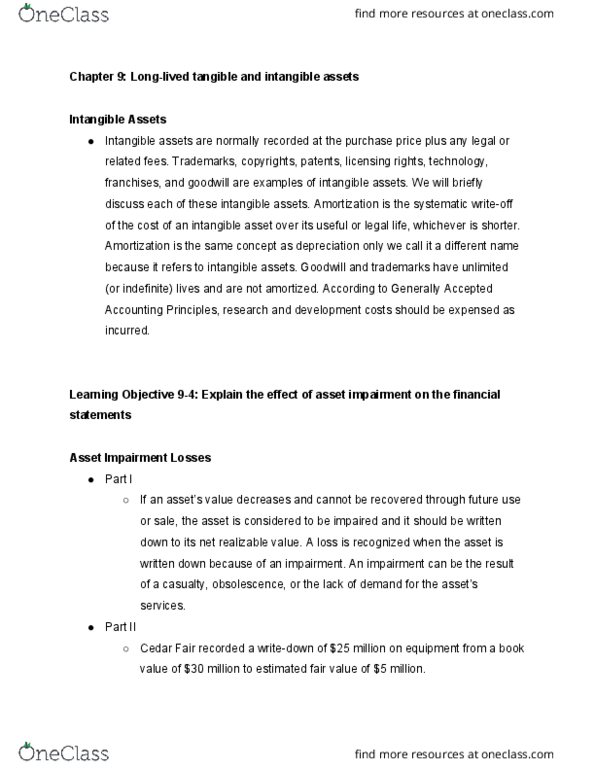ACCT 2001 Lecture 21: Chapter 9: Long lived tangible and intangible assets
Document Summary
Get access


Related Documents
Related Questions
You have obtained the following information:
STATEMENT OF COMPREHENSIVE INCOME FOR THE YEAR TO 31 DECEMBER
| 20X8 | 20X7 | |||
| Note | Draft ($m) | Actual ($m) | ||
| Revenue | (1) | 645.5 | 606.5 | |
| Other income | (2) | 15.6 | 14.4 | |
| Changes in inventories | 3.8 | (16.4) | ||
| Cost of materials | (334.1) | (286.8) | ||
| Employee benefits expense | (91.0) | (83.9) | ||
| Depreciation | (3) | (29.8) | (23.6) | |
| Other expenses | (4) | (116.3) | (100.6) | |
| Interest income, net | (5) | 12.3 | (20.9) | |
| Profit before tax | 106.0 | 130.5 | ||
| Income tax expense | (44.4) | (47.7) | ||
| Profit for the year | 61.6 | 82.8 |
STATEMENT OF FINANCIAL POSITION AT 31 DECEMBER
| 20X8 | 20X7 | |||
| Note | Draft ($m) | Actual ($m) | ||
| Assets | ||||
| Non-current assets | ||||
| Intangible assets | (6) | 47.8 | 40.5 | |
| Property, plant and equipment | (7) | 124.5 | 102.5 | |
| 172.3 | 143.0 | |||
| Current assets | ||||
| Inventories | (8) | 30.3 | 27.9 | |
| Trade receivables | 73.1 | 50.3 | ||
| Cash and cash equivalents | 111.4 | 86.0 | ||
| Total assets | 387.1 | 307.2 | ||
| Equity and liabilities | ||||
| Equity | 5.8 | 5.8 | ||
| Share capital | 15.3 | 15.3 | ||
| Share premium | 112.1 | 80.1 | ||
| Retained earnings | 133.2 | 101.2 | ||
| Non-current liabilities | ||||
| Provisions | (9) | 160.1 | 121.4 | |
| Current liabilities | ||||
| Trade payables | 33.5 | 31.8 | ||
| Tax | 50.4 | 44.3 | ||
| Other liabilities | 9.9 | 8.5 | ||
| Total equity and liabilities | 387.1 | 307.2 |
Notes
(1) Revenue from business activities:
| Revenue from business activities | ||
| 20X8 ($M) | 20X7 ($M) | |
| Vehicles | 588.0 | 526.0 |
| Parts and accessories | 39.6 | 36.8 |
| Other | 17.9 | 43.7 |
| 645.5 | 606.5 | |
Other income includes gains on the disposals of tangible assets and income from the reversal of provisions.
Average number of employees:
| 20X8 (Draft) | 20X7 (Actual) | |
| Wage earners | 484 | 499 |
| Salaried employees | 483 | 477 |
| Apprentices and trainees | 36 | 37 |
| 1,003 | 1,013 | |
Other expenses include costs for warranties, administration and distribution, maintenance and insurance.
Interest income, net:
| 20X8 (Draft ($m) | 20X7 (Actual $m) | |
| Interest and similar income | 16.8 | 25.1 |
| Interest and similar expenses | (4.5) | (4.2) |
| 12.3 | 20.9 |
Intangible assets include development costs, also franchises and industrial rights and licenses. During the year, $12.7 million (20X7 - $6.3 million) was spent on developing a new sports model, the Fox.
Property, plant and equipment:
| Land and Buildings | Equipment | Assets under construction | Total | |
| $m | $m | $m | $m | |
| Cost | ||||
| 1 January 20X8 | 61.8 | 212.1 | 19.0 | 292.9 |
| Additions | 5.0 | 28.9 | 9.4 | 43.3 |
| Disposals | 0.0 | (4.5) | 0.0 | (4.5) |
| Reclassification | 3.0 | 8.9 | (11.9) | 0.0 |
| 31 December 20X8 | 69.8 | 245.4 | 16.5 | 331.7 |
| Depreciation | ||||
| Current year | 1.9 | 18.4 | 0.0 | 20.3 |
| Accumulated | 28.7 | 178.5 | 0.0 | 207.2 |
| Net book value | ||||
| 31 December 20X8 | 41.1 | 66.9 | 16.5 | 124.5 |
| 31 December 20X7 | 34.9 | 48.6 | 19.0 | 102.5 |
(8) Inventories comprise:
| 20X8 (Draft $m) | 20X7 (Draft $m) | |
| Raw materials, consumables and supplies | 8.3 | 7.3 |
| Work-in-progress | 6.8 | 4.8 |
| Finished goods | 15.2 | 15.8 |
| 30.3 | 27.9 | |
(9) Provisions mainly cover manufacturing warranty, product liability and litigation risks. Also, provisions have been established for deferred maintenance and IT reorganization.
The following additional information is available:
(i) Pavia has achieved record sales in 20X8 with the delivery of 10,153 vehicles (20X7 â 7,642 vehicles).
(ii) Although some sales are direct to individual customers the majority are ordered through dealers who take new vehicles on consignment.
(iii) Since 1 January 20X8 Pavia has offered 0% finance for three years on new vehicle sales in its most competitive markets.
(iv) The launch of the Fox has been postponed from late 20X8 to early 20X9 as internal trials have revealed that the doors are not sufficiently secure at high speeds.
(v) A car part required for the Cipeta model is bought-in exclusively from an overseas manufacturer. Deliveries of supplies have been unpredictable in 20X7 causing disruption to the Cipeta model assembly schedules.
Given all of the information above you are required to do the following:
In respect of the financial statements audit of Pavia Co for the year ending 31 December 20X8:
Identify and explain the risks of material misstatement to be taken into account in planning the final audit.
You have obtained the following information:
STATEMENT OF COMPREHENSIVE INCOME FOR THE YEAR TO 31 DECEMBER
| 20X8 | 20X7 | |||
| Note | Draft ($m) | Actual ($m) | ||
| Revenue | (1) | 645.5 | 606.5 | |
| Other income | (2) | 15.6 | 14.4 | |
| Changes in inventories | 3.8 | (16.4) | ||
| Cost of materials | (334.1) | (286.8) | ||
| Employee benefits expense | (91.0) | (83.9) | ||
| Depreciation | (3) | (29.8) | (23.6) | |
| Other expenses | (4) | (116.3) | (100.6) | |
| Interest income, net | (5) | 12.3 | (20.9) | |
| Profit before tax | 106.0 | 130.5 | ||
| Income tax expense | (44.4) | (47.7) | ||
| Profit for the year | 61.6 | 82.8 |
STATEMENT OF FINANCIAL POSITION AT 31 DECEMBER
| 20X8 | 20X7 | |||
| Note | Draft ($m) | Actual ($m) | ||
| Assets | ||||
| Non-current assets | ||||
| Intangible assets | (6) | 47.8 | 40.5 | |
| Property, plant and equipment | (7) | 124.5 | 102.5 | |
| 172.3 | 143.0 | |||
| Current assets | ||||
| Inventories | (8) | 30.3 | 27.9 | |
| Trade receivables | 73.1 | 50.3 | ||
| Cash and cash equivalents | 111.4 | 86.0 | ||
| Total assets | 387.1 | 307.2 | ||
| Equity and liabilities | ||||
| Equity | 5.8 | 5.8 | ||
| Share capital | 15.3 | 15.3 | ||
| Share premium | 112.1 | 80.1 | ||
| Retained earnings | 133.2 | 101.2 | ||
| Non-current liabilities | ||||
| Provisions | (9) | 160.1 | 121.4 | |
| Current liabilities | ||||
| Trade payables | 33.5 | 31.8 | ||
| Tax | 50.4 | 44.3 | ||
| Other liabilities | 9.9 | 8.5 | ||
| Total equity and liabilities | 387.1 | 307.2 |
Notes
(1) Revenue from business activities:
| Revenue from business activities | ||
| 20X8 ($M) | 20X7 ($M) | |
| Vehicles | 588.0 | 526.0 |
| Parts and accessories | 39.6 | 36.8 |
| Other | 17.9 | 43.7 |
| 645.5 | 606.5 | |
Other income includes gains on the disposals of tangible assets and income from the reversal of provisions.
Average number of employees:
| 20X8 (Draft) | 20X7 (Actual) | |
| Wage earners | 484 | 499 |
| Salaried employees | 483 | 477 |
| Apprentices and trainees | 36 | 37 |
| 1,003 | 1,013 | |
Other expenses include costs for warranties, administration and distribution, maintenance and insurance.
Interest income, net:
| 20X8 (Draft ($m) | 20X7 (Actual $m) | |
| Interest and similar income | 16.8 | 25.1 |
| Interest and similar expenses | (4.5) | (4.2) |
| 12.3 | 20.9 |
Intangible assets include development costs, also franchises and industrial rights and licenses. During the year, $12.7 million (20X7 - $6.3 million) was spent on developing a new sports model, the Fox.
Property, plant and equipment:
| Land and Buildings | Equipment | Assets under construction | Total | |
| $m | $m | $m | $m | |
| Cost | ||||
| 1 January 20X8 | 61.8 | 212.1 | 19.0 | 292.9 |
| Additions | 5.0 | 28.9 | 9.4 | 43.3 |
| Disposals | 0.0 | (4.5) | 0.0 | (4.5) |
| Reclassification | 3.0 | 8.9 | (11.9) | 0.0 |
| 31 December 20X8 | 69.8 | 245.4 | 16.5 | 331.7 |
| Depreciation | ||||
| Current year | 1.9 | 18.4 | 0.0 | 20.3 |
| Accumulated | 28.7 | 178.5 | 0.0 | 207.2 |
| Net book value | ||||
| 31 December 20X8 | 41.1 | 66.9 | 16.5 | 124.5 |
| 31 December 20X7 | 34.9 | 48.6 | 19.0 | 102.5 |
(8) Inventories comprise:
| 20X8 (Draft $m) | 20X7 (Draft $m) | |
| Raw materials, consumables and supplies | 8.3 | 7.3 |
| Work-in-progress | 6.8 | 4.8 |
| Finished goods | 15.2 | 15.8 |
| 30.3 | 27.9 | |
(9) Provisions mainly cover manufacturing warranty, product liability and litigation risks. Also, provisions have been established for deferred maintenance and IT reorganization.
The following additional information is available:
(i) Pavia has achieved record sales in 20X8 with the delivery of 10,153 vehicles (20X7 â 7,642 vehicles).
(ii) Although some sales are direct to individual customers the majority are ordered through dealers who take new vehicles on consignment.
(iii) Since 1 January 20X8 Pavia has offered 0% finance for three years on new vehicle sales in its most competitive markets.
(iv) The launch of the Fox has been postponed from late 20X8 to early 20X9 as internal trials have revealed that the doors are not sufficiently secure at high speeds.
(v) A car part required for the Cipeta model is bought-in exclusively from an overseas manufacturer. Deliveries of supplies have been unpredictable in 20X7 causing disruption to the Cipeta model assembly schedules.
1. Evaluate how you might use analytical procedures to provide audit evidence and reduce the level of detailed substantive procedures.
N.B these are pointers are for this question:
Analytical Procedures - Examples: o Receivables - Receivables - Compare gross margin % with previous years (by product line). (Possible misstatement â Over/understatement of sales and accounts receivable). This analytics will reduce the detailed substantive procedure because we have identified that there may be a possible over/understatement of sales so now we need to perform additional audit procedures on sales/revenue. For example by selecting a sample of invoices generated throughout the year and comparing to the General Ledger to ensure completeness and accuracy. Note: Use the information in the case to calculate the analytical procedures you have identified. Also, explain how the analytical procedures will provide audit evidence and help to reduce the level of detailed substantive procedures.
You have obtained the followinginformation:
STATEMENT OF COMPREHENSIVE INCOME FOR THE YEAR TO 31DECEMBER
20X8 | 20X7 | |||
Note | Draft ($m) | Actual ($m) | ||
Revenue | (1) | 645.5 | 606.5 | |
Other income | (2) | 15.6 | 14.4 | |
Changes in inventories | 3.8 | (16.4) | ||
Cost of materials | (334.1) | (286.8) | ||
Employee benefits expense | (91.0) | (83.9) | ||
Depreciation | (3) | (29.8) | (23.6) | |
Other expenses | (4) | (116.3) | (100.6) | |
Interest income, net | (5) | 12.3 | (20.9) | |
Profit before tax | 106.0 | 130.5 | ||
Income tax expense | (44.4) | (47.7) | ||
Profit for the year | 61.6 | 82.8 |
STATEMENT OF FINANCIAL POSITION AT 31DECEMBER
20X8 | 20X7 | |||
Note | Draft ($m) | Actual ($m) | ||
Assets | ||||
Non-current assets | ||||
Intangible assets | (6) | 47.8 | 40.5 | |
Property, plant and equipment | (7) | 124.5 | 102.5 | |
172.3 | 143.0 | |||
Current assets | ||||
Inventories | (8) | 30.3 | 27.9 | |
Trade receivables | 73.1 | 50.3 | ||
Cash and cash equivalents | 111.4 | 86.0 | ||
Total assets | 387.1 | 307.2 | ||
Equity and liabilities | ||||
Equity | 5.8 | 5.8 | ||
Share capital | 15.3 | 15.3 | ||
Share premium | 112.1 | 80.1 | ||
Retained earnings | 133.2 | 101.2 | ||
Non-current liabilities | ||||
Provisions | (9) | 160.1 | 121.4 | |
Current liabilities | ||||
Trade payables | 33.5 | 31.8 | ||
Tax | 50.4 | 44.3 | ||
Other liabilities | 9.9 | 8.5 | ||
Total equity and liabilities | 387.1 | 307.2 |
Notes
(1)Revenue from businessactivities:
Revenue from business activities | ||
20X8 ($M) | 20X7 ($M) | |
Vehicles | 588.0 | 526.0 |
Parts and accessories | 39.6 | 36.8 |
Other | 17.9 | 43.7 |
645.5 | 606.5 | |
(2)Other income includes gains on the disposals oftangible assets and income from the reversal ofprovisions.
(3)Average number of employees:
20X8 (Draft) | 20X7 (Actual) | |
Wage earners | 484 | 499 |
Salaried employees | 483 | 477 |
Apprentices and trainees | 36 | 37 |
1,003 | 1,013 | |
(4)Other expenses include costs for warranties,administration and distribution, maintenance andinsurance.
(5)Interest income, net:
20X8 (Draft ($m) | 20X7 (Actual $m) | |
Interest and similar income | 16.8 | 25.1 |
Interest and similar expenses | (4.5) | (4.2) |
12.3 | 20.9 |
(6)Intangible assets include development costs, alsofranchises and industrial rights and licenses. During the year,$12.7 million (20X7 - $6.3 million) was spent on developing a newsports model, the Fox.
(7)Property, plant and equipment:
Land and Buildings | Equipment | Assets under construction | Total | |
$m | $m | $m | $m | |
Cost | ||||
1 January 20X8 | 61.8 | 212.1 | 19.0 | 292.9 |
Additions | 5.0 | 28.9 | 9.4 | 43.3 |
Disposals | 0.0 | (4.5) | 0.0 | (4.5) |
Reclassification | 3.0 | 8.9 | (11.9) | 0.0 |
31 December 20X8 | 69.8 | 245.4 | 16.5 | 331.7 |
Depreciation | ||||
Current year | 1.9 | 18.4 | 0.0 | 20.3 |
Accumulated | 28.7 | 178.5 | 0.0 | 207.2 |
Net book value | ||||
31 December 20X8 | 41.1 | 66.9 | 16.5 | 124.5 |
31 December 20X7 | 34.9 | 48.6 | 19.0 | 102.5 |
(8)Inventories comprise:
20X8 (Draft $m) | 20X7 (Draft $m) | |
Raw materials, consumables and supplies | 8.3 | 7.3 |
Work-in-progress | 6.8 | 4.8 |
Finished goods | 15.2 | 15.8 |
30.3 | 27.9 | |
(9) Provisions mainly covermanufacturing warranty, product liability and litigation risks.Also, provisions have been established for deferred maintenance andIT reorganisation
The following additional information isavailable:
(i) Pavia has achieved record sales in 20X8 with the delivery of10,153 vehicles (20X7 â 7,642 vehicles).
(ii) Although some sales are direct to individual customers themajority are ordered through dealers who take new vehicles onconsignment.
(iii) Since 1 January 20X8 Pavia has offered 0% finance forthree years on new vehicle sales in its most competitivemarkets.
(iv) The launch of the Fox has been postponed from late 20X8 toearly 20X9 as internal trials have revealed that the doors are notsufficiently secure at high speeds.
(v) A car part required for the Cipeta model is bought-inexclusively from an overseas manufacturer. Deliveries of supplieshave been unpredictable in 20X7 causing disruption to the Cipetamodel assembly schedules.
Given all of the information above you are requiredto do the following:
In respect of the financial statements audit of Pavia Co for theyear ending 31 December 20X8:
(a) Identify and explain the risks of materialmisstatement to be taken into account in planning the finalaudit.
(b) Evaluate how you might use analytical procedures to provideaudit evidence and reduce the level of detailed substantiveprocedures.
(c) Briefly describe the principal audit work to be performed inrespect of the carrying amount of the following items in thestatement of financial position.
(i) Inventories
(ii) Cash and cash equivalents
(iii) Receivables


